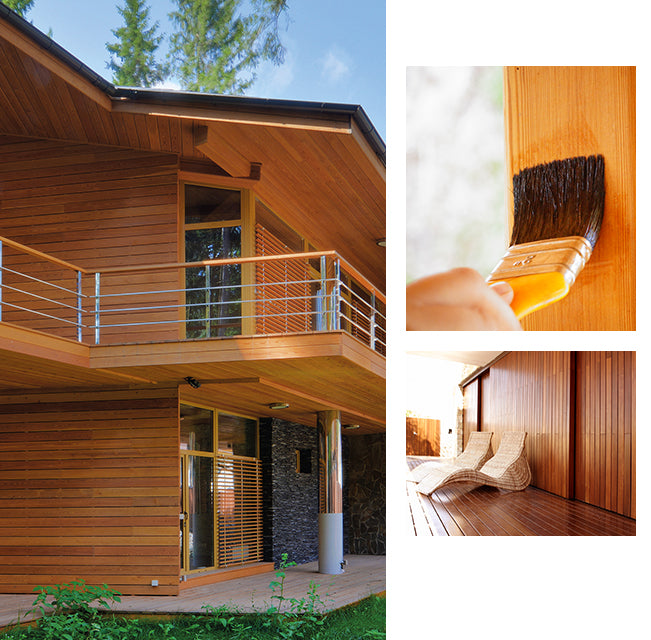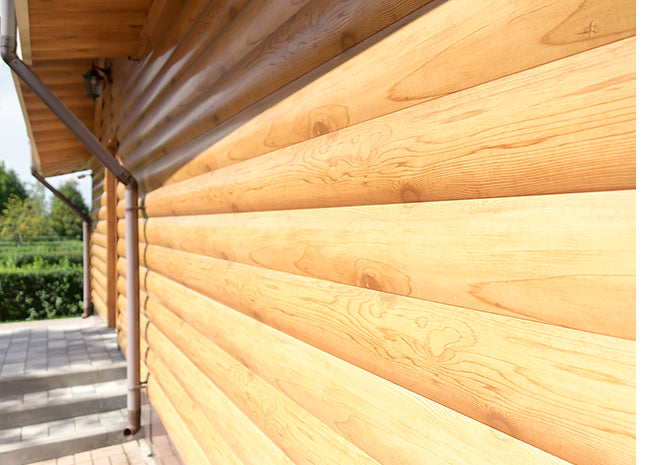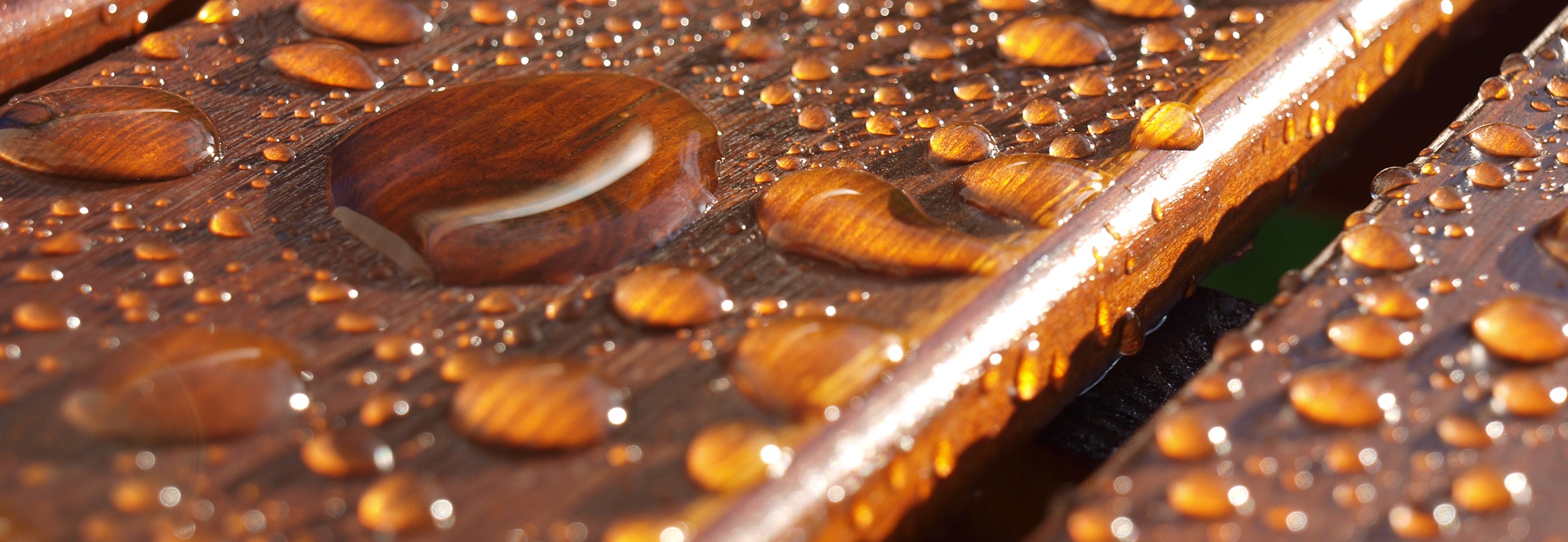Wood Glazes & Care
Due to its natural qualities, warmth, and versatility, wood is one of the most popular building materials. To keep it looking good and functioning well long-term, it needs special care. Our wood glazes, oils, and opaque wood finishes offer effective protection and maintain its breathability.

subheading
Wood stain, varnish, oil – which paint do I use for what?
Wood is a popular material today and is used both indoors and outdoors. Whether it's furniture, fences or privacy screens, the natural look and the wood look make a difference. Wood is robust, but very sensitive to environmental influences and moisture. If you want to get a long life out of your garden furniture, you can't avoid painting it with a wood glaze. The transparent glaze protects the wood surface from the effects of the weather and at the same time skilfully highlights the grain. If you want, you can even paint the components in any color you want. Below we'll show you everything you need to know about wood glazes, what the differences are between wood varnish, wood oil and wood glazes and how to apply the wood protection correctly.
subheading
What do I use...
wood varnish?
A wood varnish is a covering coat that protects the wood from the effects of the weather and also makes it more durable. You can use it to protect the wood surface and give it a new look at the same time. Wood protection varnishes are available in numerous colors. In terms of surface appearance, you can choose a high-gloss finish, for example. A distinction is made between solvent-based acrylic varnish, synthetic resin varnish with solvents and environmentally friendly varnishes that are free of solvents, do not contain harmful substances and do not produce an unpleasant smell. These are therefore ideal for indoor use. Weatherproof paints are used outdoors and also protect against UV radiation. The disadvantages of wood varnishes: They cover up the natural grain of the wood and weatherproof paint is not the right choice for every surface.
wood oil?
Wood oils are intended for the care of surfaces and are not a wood preservative. Nevertheless, it is important to oil wood regularly. The raw material dries out over time and quickly loses its attractive appearance. The oils penetrate deep into the component made of the natural material, extend its lifespan and restore the desired wood look. They are used for garden furniture, the subfloor of the terrace and for indoor furniture. The BAUFIX wood care oil is just right for the care of untreated hardwood garden furniture such as tables, chairs or benches, but is just as suitable for wooden terraces and walkways. We recommend the BAUFIX teak care oil especially for teak.
wood stain?
A wood glaze is a transparent wood protection that does not leave a covering layer on the wood surface, but rather emphasizes the natural wood grain. The coating makes the wood resistant to the effects of weather and is significantly more robust. Wood glazes are divided into thin-layer glazes and thick-layer glazes. The difference between the layers of the coating is that the thin-layer glazes penetrate the wood and protect it from the inside out, while the thick-layer glazes form a thick coating on the surface. The first type of glaze is suitable for non-dimensionally stable components, while the second type of wood glaze is the best choice for dimensionally stable components. The BAUFIX professional UV-Protect thick-layer glaze has been awarded the “Blue Angel” seal as a coating.
Info check: Dimensionally stable components are wood that is barely allowed to change in shape, such as windows or doors. Non-dimensionally stable components, on the other hand, are allowed to change in volume, such as fences or planking.

subheading
How do I choose the color for the wood stain?
subheading
A wood stain can be opaque or appear as a transparent coating. If you want to continue to show off the wood grain, choose a colorless wood stain. If you want to make a visual change, use a wood paint when painting. These are available in almost every color, such as red, yellow or blue. Some colors also allow the grain to shine through slightly.
subheading
Care and refreshment: When is the next varnish due?
In general, wood protection is very important outdoors. The coating protects the raw material, making it durable and resistant. A glaze should be refreshed at regular intervals so that the protective function is still present. How long a glaze actually protects depends on the conditions to which the wooden surface is exposed outdoors. Factors such as weather, type of wood, mechanical stress and color all play a role, as dark colors generally last longer.
Therefore, ideally, check the wood protection coating at regular intervals. According to experts, maintenance should be carried out at least once a year, including thorough cleaning of dirt and dust and a new coat of wood stain.
subheading
What are the differences between wood stains?
Wood glazes are divided into glazes for indoor and outdoor use, which are chosen either as thin-layer glazes or thick-layer glazes.
Differences: Thick-layer glaze or thin-layer glaze?
The thin-layer glaze is a liquid wood glaze and therefore penetrates deep into the wood. The wood glaze protects the wood from the inside out and makes it more resistant. The thin-layer glaze is ideal for outdoor use. As it contains solvents that evaporate heavily, the wood varnish is not suitable for indoor use.
A thick-layer glaze, on the other hand, is a viscous layer and forms a film on the surface. The thick-layer glaze therefore hardly penetrates the material, and the protective layer ensures weather resistance outdoors, but can also be used indoors.
The middle layer glaze coating is the middle ground between the two variants. A middle layer glaze penetrates deeper into the wood and creates a thinner coating.
Tip: Thin-layer glazes must be refreshed regularly with a new coat of paint. Thick-layer glazes only flake off after several years, but then have to be renewed at a more complex cost, as the coating of the thick-layer glaze must first be removed.
subheading
Finding the right wood stain
In order to choose the right wood glaze for your purpose, you should take other factors into account. Above all, it depends on the properties of the component, which only the right wood glaze can protect accordingly. Therefore, before applying the wood protection glaze , you should ask yourself whether you want to use a colored or transparent glaze. The latter has the advantage that the grain is skilfully highlighted. You also need to clarify whether the wood should be dirt and water repellent after being coated with the wood glaze. Do you need a glaze that protects against mold or protects the wood from UV rays? The liquid glazes have ingredients that provide excellent protection against fungal and insect infestation as well as UV radiation. Without the right wood glaze, the surface can quickly turn gray. The "breathing" - i.e. how permeable the wood is to diffusion with the wood glaze - should also be clarified. This means that moisture is absorbed but also released again.
Make sure that heavily used surfaces should be painted with an appropriate varnish and not treated with a wood glaze. For example, BAUFIX Stairs & Parquet Varnish is suitable for all wooden floors and ensures a robust and hard-wearing surface indoors. To ensure that floors remain visually appealing for a long time, we recommend regular care with BAUFIX Stairs & Parquet Care .
subheading
Now that you have found the right wood stain, you can start applying it. Below we will show you step by step how to apply the stain correctly. You will need:
- the right wood stain for indoor or outdoor use
- Painting tools such as brushes or rollers like our BAUFIX paint roller set
- Sandpaper: grain between 280 and 320
- Tarpaulin, conveniently available in our BAUFIX masking set
- protective gloves
- possible turpentine for cleaning the brushes
Step 1: First, start by sanding the wood surface. To do this, use sandpaper with the appropriate grain. When sanding, always work in the direction of the wood grain and not against it. This protects the sensitive wood fibers. Then clean the surface thoroughly and remove dust and dirt. The surface must be dry, clean and free of grease before applying the wood stain.
Step 2: To ensure that you and your surroundings are well protected from paint splashes and dripping glaze, cover everything with the tarpaulin and put on protective gloves.
Step 3: Now you can start working with the wood stain. Take a brush or roller, dip it in the wood stain and paint garden furniture, fences, etc. evenly with the wood protection stain or wood paint, if it also contains color pigments. If you want to use the painting tool again later, clean it with turpentine immediately after painting.
Step 4: Now let the wood stain dry for a good 16 hours. For the best results, you can lightly sand the surfaces again and apply the wood stain a second time.
There is a difference between a base coat, an intermediate coat and a final coat. Before you apply a glaze, it is important to sand it down to ensure better adhesion. You also ensure that the surface is smooth and structured. It may be a good idea to apply a primer before the glaze. This can protect against mold and fungi, such as the BAUFIX wood protection primer . Priming is particularly suitable for outdoor areas to ensure a high level of weather protection. If you sand, prime and glaze, the last step is to apply a clear coat for the finish.
subheading
Do I have to sand wooden furniture before varnishing it? Should I apply wood varnish with a brush or roller?
In order to apply the wood glaze properly and to easily apply the layer of wood protection glaze , you need the appropriate painting tools. Use a brush with a wide handle for painting. Depending on the size of the surface, use large brushes for full surfaces or choose a small version for fine work. Oils have the advantage of being easy to apply with a cloth. There are special glaze brushes for wood glazes for professional glazing. If you want to paint large surfaces, use a paint roller or choose a short-pile paint roller. In any case, pay attention to the manufacturer's information, which will tell you which wood glazes etc. the painting equipment is suitable for.
Our recommendations for wood stain
If you want to protect your wood outdoors, we recommend the BAUFIX decorative long-term glaze as a weatherproof and UV-resistant wood glaze for all softwoods and hardwoods. If you want even more durability, then the BAUFIX PUR long-term glaze is just right for you. It is environmentally friendly with our natural series such as the BAUFIX natural weather protection wood gel , the BAUFIX natural decorative long-term glaze and the BAUFIX living room glaze especially for indoor use. We also offer you a large selection of special paints such as our BAUFIX terrace and garden furniture glaze . We are happy to help you with the selection. This way you always have the best protection for your wood.



